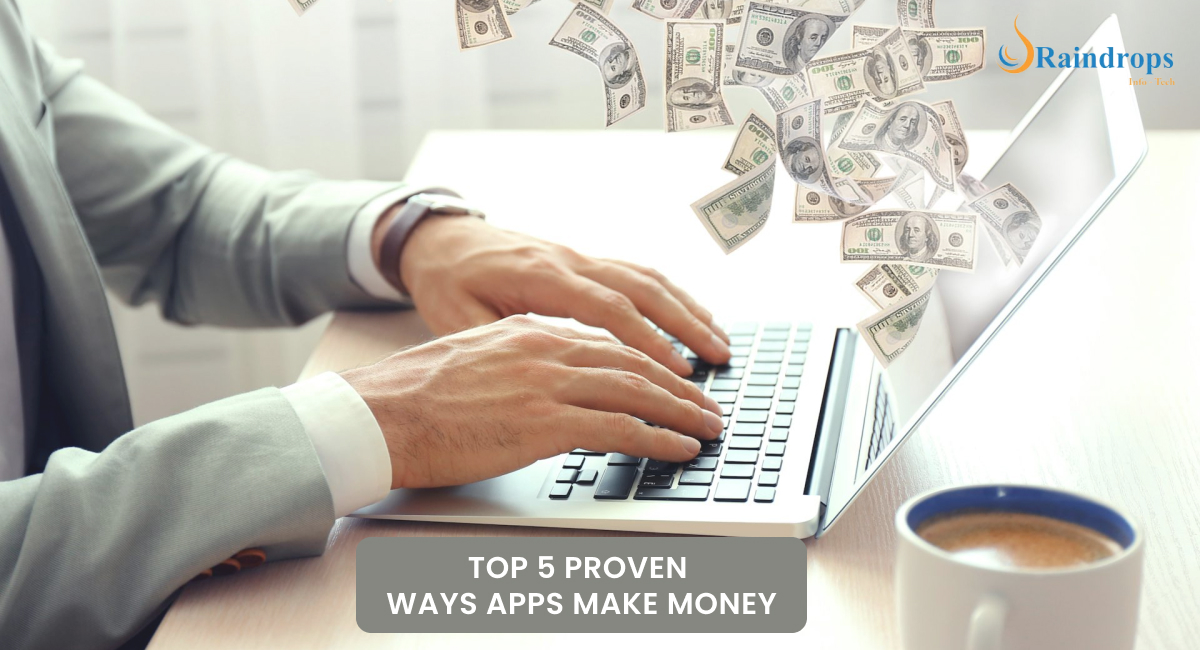Top 5 App Monetization Models: How Apps Make Money?
Considering the importance of having an app for business, imagine you have invested money in building it. But, how to make sure it brings you back the money you put in? In today’s world, apps are a means to network, expand and connect with your customers. But have you ever wondered how do apps make money? This guide here lists down key app monetization models in detail so that you have all the information you need on app revenue generation.

1. In-App Advertising
Firstly, we have In-app advertising. It is one of the most popular ways free apps make money. Here are some types of ads:
-
Banner Ads: Small ads that show up at the top or bottom of the screen without interrupting the app experience.
-
Interstitial Ads: Full-screen ads that appear at certain times, like between game levels.
-
Video Ads: Often reward-based; users can earn in-app rewards (like coins or lives) by watching these ads.
-
Native Ads: Ads that match the app’s look and feel, making them blend in and feel less disruptive.
In-app ads work best for apps with large user bases, where frequent engagement ensures that ads have a higher chance of being seen. Advertisers often choose ad formats and placements that fit well with the app and enhance the user experience based on data.
Pros:
-
Works well in free apps.
-
Offers flexibility with ad types.
Cons:
-
Can disrupt user experience if not implemented thoughtfully.
-
Revenue is dependent on a large user base with frequent engagement.

2. Freemium Model
Next we have the freemium model. It may sound weird, but you are sure to be familiar with this. This model provides users with basic features for free, while premium features are available for a fee. This approach is common in productivity apps and social media platforms.
-
Free Version: Users access essential features without paying, helping the app reach a broad audience.
-
Premium Version: Advanced functions and features are offered as paid options, tempting users to upgrade after experiencing the value of the free version.
Popular apps like Spotify and LinkedIn apply this model, offering free access but always pushing for upgrades to provide ad-free experiences.
Pros:
-
Attracts a wide audience with no initial cost.
-
Encourages user upgrades with exclusive features.
Cons:
-
May ignore users who feel pressured to upgrade.
-
Can be challenging to determine the right balance between free and premium features.

3. Subscription Model
Most of you must have bought a Netflix or Hotstar subscription where you pay on a monthly or yearly basis to get access to their content. This is what the subscription model is. Subscription-based app monetization is popular for apps that offer ongoing content or services, like news, fitness, and streaming platforms. This app monetization model offers several benefits:
-
Regular Revenue: Subscriptions provide a dependable stream of income. Since payments are recurring, the app can count on regular earnings.
-
User Retention: Subscribers tend to stick around if they see value in the content or features. Exclusive content and regular updates keep them engaged.
-
Flexibility: Subscription plans can vary—weekly, monthly, or yearly options make it easier for people to find a plan that suits their budget.
Many apps use a “freemium” model, offering free trials or basic versions to attract users. Once hooked, users can opt for a paid plan to access more features or exclusive content. This payment model is great for companies that want to keep their revenue steady and predictable over time.
Pros:
-
Generates consistent revenue.
-
Increases customer loyalty.
Cons:
-
Relies on new subscribers to balance out those who may cancel.
-
To keep people interested, apps need to consistently release new content or features.
Subscription models are ideal for apps that continuously deliver value, helping build a loyal customer base while providing the company with a stable income.

4. Sponsorships and Partnerships
Moving ahead, we have another option through which apps make money — Sponsorships and Partnerships. Sponsorships are ideal for niche apps with a loyal user base. With this model, app owners collaborate with brands to feature sponsored content within the app.
-
Exclusive Sponsorships: Here, a single sponsor supports the app for a given time. In return, they get special visibility and access to the app’s audience.
-
Integrated Campaigns: The app includes ads, special offers, or discounts from brands that match the interests of its users. This makes the ads feel more relevant and less like spam, boosting user engagement.
This strategy allows app developers to generate revenue while offering users valuable deals. It’s especially effective for fitness or lifestyle apps, where advertisers are closely aligned with the app’s content and user interests.
Pros:
-
Provides value-added content to users.
-
Offers additional revenue without disturbing user experience.
Cons:
-
This model only works well for apps with a specific niche, so it doesn’t suit general-use apps.
-
If sponsorships don’t match users’ interests, it can push them away or make them lose interest in the app.

5. Affiliate and Referral Marketing
Last but not the least, we have social media’s favourite — Affiliate Marketing. Apps can generate income through affiliate marketing by promoting third-party products or services and earning a commission on conversions. Common in e-commerce and travel apps, it blends smoothly with the app’s content.
-
Affiliate Links: Users are directed to external sites or products, with the app earning a percentage on sales.
-
Referral Codes: Users share referral codes, earning app-specific rewards for every successful referral.
This strategy works particularly well in shopping, travel, or financial service apps where users are open to exploring additional resources. Apps make money through partnerships with companies that offer products relevant to their audience.
Pros:
-
Integrates well with shopping or travel apps.
-
Encourages user engagement through rewards.
Cons:
-
Success relies heavily on user engagement with third-party links.
-
Can damage credibility if affiliate products are irrelevant or of low quality.

Choosing the Right App Monetization Model
We have mentioned the top 5 ways/ models on how apps make money. But, it is of no use if you don’t choose the correct one for your app. So, make sure to consider these points while selecting an app monetization strategy.
-
Target Audience – Determine how much your audience is willing to spend and whether they prefer ads, subscriptions, or one-time payments.
-
App Type – The nature of your app influences the best model. For example, games might benefit from in-app purchases, while productivity apps thrive on the freemium model.
-
Market Analysis – Research what app monetization models similar apps are using successfully.
Why is Raindrops Infotech your best partner for app development?
Ready to launch an app with a solid plan to make money? Raindrops Infotech is here to help turn your vision into reality! With our years of experience in app development and digital strategy, we know how to create apps that not only perform well but also generate income. Whether you’re thinking about freemium models, in-app purchases, or a smart mix of strategies, we’ll guide you to the most profitable choice. Let’s build an app that engages your users and boosts your revenue. Schedule a free consultation and get in touch with Raindrops Infotech today!
